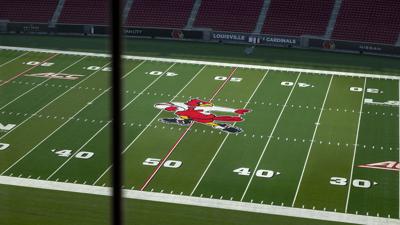LOUISVILLE, Ky. (WDRB) -- The University of Louisville's athletic department is entering the 2025-26 fiscal year with something it has never included in its budget before: direct payments to athletes.
That line item — totaling $20.5 million — reflects the most immediate impact of the NCAA's House settlement, which will allow Division I schools to share up to $22.5 million annually with athletes starting this fall. For Louisville, it's a financial and philosophical shift that reaches into nearly every part of its athletic operation.
And it comes at a cost.
The budget approved Wednesday by the U of L Athletic Association anticipates $167.4 million in expenses but just $154.9 million in revenue, leaving a projected $12.5 million deficit for the coming year. The shortfall would be significantly larger if not for a dramatic increase in university support — $12 million in direct institutional aid, with a proposed $5.4 million student athletic fee still awaiting final approval.
Take away the university assistance, and Louisville athletics would be nearly $24.5 million short of balancing its books.
To help stabilize the next two to three seasons, the department has secured a $25 million line of credit from PNC Bank.
A $22 million impact
The House settlement upended the amateur framework of college sports, clearing the way for revenue-sharing agreements between schools and athletes. At Louisville, the immediate costs include:
- $20.5 million in athlete revenue sharing
- $450,000 in new administrative expenses
- $1 million in reduced NCAA distributions, a portion of which will help fund back pay for former athletes under the settlement
In response, Louisville restructured financial aid to save $3.4 million, reduced travel and meal expenses, added new processing fees to ticket sales and froze capital spending — halting a routine stream of facility upgrades that has defined the past decade.
But those internal measures weren't enough.
University steps in
To offset the growing gap, U of L increased its institutional support to $12 million, up from around $6–8 million in recent years. If the proposed athletic fee is enacted, that total could climb to more than $17 million.
Louisville isn't alone. As schools across the country confront the financial reality of athlete compensation, a growing number are leaning on direct university support — or in some cases, student fees — to remain competitive.
Even with those measures, the athletic department projects a significant shortfall. Its reserves, which peaked at more than $34 million in 2014, have dropped to about $3.4 million, and most of that is restricted — earmarked for specific uses and unavailable for basic operations.
That made the approval of a $25 million draw-down line of credit a critical move. Backed by university-held investment assets, the loan allows the department to access cash as needed. The terms call for interest-only payments for five years, with an option to refinance at the end of the term.
Revenue realities
Despite rising costs, revenue growth remains modest. Football ticket sales are projected to increase by $3 million, thanks to eight home games and a surge in fan interest. Men's basketball, now under new head coach Pat Kelsey, is expected to generate an additional $1 million — roughly equal to the raise Kelsey received after his first season.
Meanwhile, sponsorship income is declining, due in part to changes in the L&N Stadium naming rights deal and the changing structure of sponsorships, many of which have been front-loaded. Donor giving has increased slightly but remains a relatively small share of the overall budget.
Louisville | Kentucky | Indiana | Bozich & Crawford
The hope: Performance and payouts
U of L is banking on performance to close the gap. If the football team finishes in the College Football Playoff Top 25, it would receive an additional $1.7 million in revenue, with a full playoff berth delivering as much as $8 million. The Cardinals narrowly missed that Top 25 payout last season — a loss at Stanford likely sealed the shortfall.
Basketball presents another opportunity. NCAA Tournament “unit” payouts range from $60,000 to $300,000 per game played, depending on how deep a team goes.
If all goes right — with strong showings in football, men's and women's basketball, and steady ticket sales — the projected deficit could shrink to less than $350,000. But that scenario depends on near-perfect execution across the board.
A broader reckoning
Louisville is far from the only program feeling the squeeze. The University of Michigan recently projected a $15 million deficit. Kentucky announced a $31 million shortfall over two years. Across the Power 5, the traditional model of athletic self-sufficiency is unraveling, as schools begin paying athletes directly while still trying to preserve competitive and operational excellence.
U of L officials presented the budget virtually on Wednesday, with athletic director Josh Heird and university president Gerry Bradley participating from the College World Series in Omaha. Media questions were not taken.
The new budget, in many ways, provides Louisville with a financial roadmap for the next two years. But it also illustrates the fragile balancing act that now defines major college sports.
Copyright 2025 WDRB Media. All Rights Reserved.

